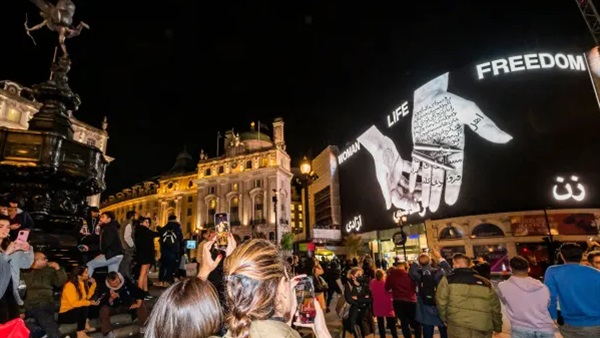Iranian artists call for boycott of cultural institutions with links to regime

Dozens of Iranian artists have called for an international boycott of cultural institutions run by or affiliated with the Islamic Republic in protest against the regime’s worsening human rights abuses.
The call by artists, writers, film-makers and academics living in Iran and among its diaspora comes amid growing anti-government art activism by Iranians inside and outside the country after the death of 22-year-old Mahsa Amini.
More than 6,000 Iranian cultural figures have signed a statement in support of art students in the country who are facing arrest and intimidation for taking part in the protests, which began 10 weeks ago.
The organisers of that letter have now published a plea for their peers around the world to “boycott governmental institutions of the Islamic state of Iran and their covert affiliates, and prevent them from having any presence in international arenas of arts, culture and education”.
They condemned the “increasingly brutal, violent and deadly state crackdown” against anti-government protesters, in which an estimated 300 people have been killed and 14,000 arrested.
One of the core members of the group has called for direct action against arts organisations that take funding from the Iranian regime, similar to the protests mounted against museums and galleries funded by the Sackler family, benefactors descended from the American makers of addictive opioid prescription drugs.
Vali Mahlouji, a London-based curator, said this could involve lobbying international art fairs to not exhibit certain Iranian galleries. “We know that some private Iranian galleries are connected to the money systems of the Iranian state, including the Islamic Revolutionary Guards Council,” said Mahlouji. “They need to be boycotted.”
The artist Jinoos Taghizadeh, who took part in street protests in Tehran after Amini’s death and was teargassed, said some seemingly independent galleries “have been the money-laundering arm of the government” and have “tried to depoliticise [Iranian] artists”. “I support and expect international cultural institutions to boycott them,” she said.
Provoked by Amini’s death while in police custody following charges that she was wearing the hijab inappropriately, artists in Iran have created public installations that reflect the brutality of the regime.
In October, an anonymous artist created “Tehran sinking in blood” by dyeing fountains in parks red. In response to a crackdown on demonstrators at Tehran’s Sharif University, two anonymous female artists hung red nooses from trees in Daneshjoo Park.
“This is a society saying we are terrorised,” said Mahlouji. “There is a big performative response: people tying themselves up; red ink being poured on pictures of the founder of the Islamic Republic [Ayatollah Khomeini]; red paint being thrown at buildings; even urinating outside art galleries which have kept themselves open when artists demanded that they close down.”
In New York last month, the Anonymous Artist Collective for Iran unfurled 12 red banners inside the Guggenheim Museum covered with stencils depicting Amini and the words “Woman, Life, Freedom” in English and Kurdish.
Taghizadeh, who is now in Canada, raised the plight of art students in Iran whom she said “have been very brave and creative despite all the repressions, arrests, kidnappings”. Videos of their anti-government performances and protests on campus have gone viral on social media.
She said: “They were constantly threatened by the police and university security, but the performance of their music and protest songs and their publication on social media both encouraged the protesters and brought the voice of protest to other cities and outside Iran.”
Taghizadeh called on international galleries and museums to exhibit Iranian art that supports the spirit of the “women, life, freedom” movement, rather than shows that reinforce “the exotic stereotypes of the Middle East and the Islamic world”.
The artist Shirin Neshat, who last month showed a digital art piece called Woman Life Freedom at Piccadilly Circus, London, and at Pendry West Hollywood in Los Angeles to highlight worsening human rights abuses in Iran, said: “We are not just a bunch of oppressed artists trying to get the western culture to feel sorry for us. We’re teaching them that it is time to wake up and understand that culture plays a big part in the political fabric of our world.”
Neshat, who signed the letter in support of Iranian art students, said she was “learning so much from them”. “Not only by their resistance and protests, but by their imagination,” she said. “How within the parameters that they’re dealing with they continue to be imaginative and creative in fighting back.”
The artist, who in 1996 was banned from returning to Iran, added: “We see these young people who are completely fearless facing tyranny. You really question your own state of mind as an Iranian who has never been able to live without fear for so many years. It’s extremely hopeful to have these young people who are saying no more fear.”







